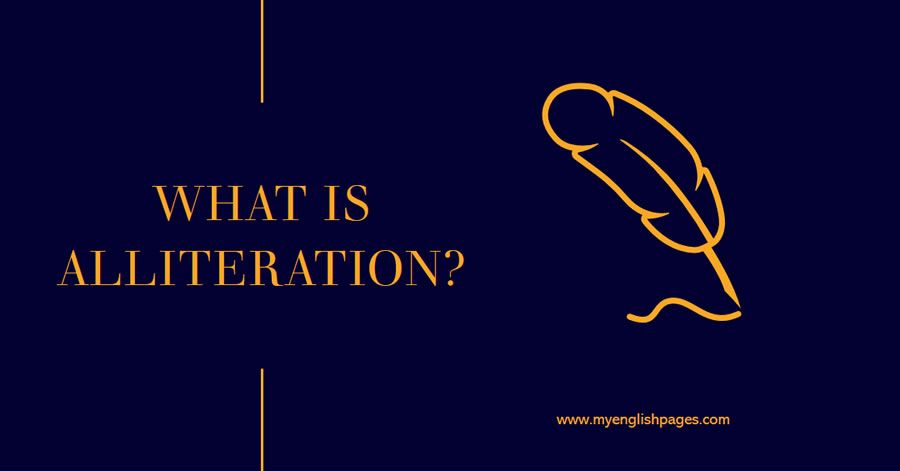Table of Contents
Introduction
Alliteration is a literary device characterized by the repetition of initial consonant sounds in close proximity, enhancing rhythm, creating emphasis, and contributing to a memorable and melodious quality in language. In this article, we will define this figure of speech and provide examples fro literature to illustrate the concept.
Let’s start first bu understanding what alliteration means.
What is Alliteration in Literature?
Alliteration is a figure of speech in which a sequence of words in a sentence or phrase begins with the same consonant sound, lending a rhythmic and musical quality to the language.
This device is commonly used in poetry, prose, and even in branding or advertising for its ability to create a memorable and aesthetically pleasing impact.
Examples include phrases like:
- Sally sells seashells by the seashore.
- Peter Piper picked a peck of pickled peppers.
The repeated “s” and “p” sound add a melodic and rhythmic quality.
Here are more examples:
- Sweet smell of success
- A dime a dozen
- Bigger and better
- Jump for joy
- Share a continent but not a country
- Cream of the crop
- French fry
- Tough talk
- Trick or treat
But why is alliteration is a powerful figure of speech? Let’s discover why in the following section!
Alliteration Vs Assonance Vs Consonance
Alliteration, assonance, and consonance are related sound devices used in language and poetry, but they involve different types of repetition.
- Alliteration:
- Definition: Alliteration refers to the repetition of initial consonant sounds in a sequence of words within close proximity.
- Example: “She sells seashells by the seashore.” The repeated “s” sound at the beginning of words is an example of alliteration.
- Assonance:
- Definition: Assonance involves the repetition of vowel sounds within nearby words, irrespective of the surrounding consonant sounds.
- Example: “The rain in Spain falls mainly on the plain.” The repetition of the long “a” sound in “rain,” “Spain,” and “mainly” is an instance of assonance.
- Consonance:
- Definition: Consonance is the repetition of consonant sounds, which can occur at the beginning, middle, or end of words.
- Example: “Blank and think.” The repetition of the “nk” sound at the end of words is an example of consonance.
Summary:
- Alliteration involves the repetition of initial consonant sounds.
- Assonance involves the repetition of vowel sounds.
- Consonance involves the repetition of consonant sounds, which can occur at various positions within words.
Why is Alliteration Used?
Alliteration, whether in literature, branding, or public speaking, is as an impactful tool that enhances communication through its rhythmic, memorable, and attention-grabbing qualities.
This figure of speech not only contributes to the overall sound and rhythm of a piece but also serves as a stylistic tool to emphasize certain words or ideas.
Here are a few reasons why alliteration is a powerful tool:
- Versatility Across Literature:
- Alliteration finds its place in various types of literature, with a notable prevalence in poetry.
- It enhances the auditory experience for readers, creating a rhythmic and musical quality in the language.
- Attention-Grabbing in Business and Advertising:
- Businesses and advertisers strategically employ alliteration to capture attention.
- The repetition of consonant sounds at the beginning of words in company names or product slogans serves to make them more memorable and engaging.
- Rhythm and Memorability:
- The repetition of consonant sounds allows for the establishment of a captivating rhythm in language.
- Alliterative phrases are often easier to memorize, adding a mnemonic quality that contributes to their lasting impact.
- Enjoyable Reading and Speech:
- Alliteration is a powerful rhetorical tool used by public speakers, poets and writers because it adds a persuasive and memorable dimension to speeches, emphasizing key points and making the message more impactful.
- Alliteration makes phrases enjoyable to read or say out loud due to their rhythmic and melodic nature.
- Business Success Stories:
- Recognizable brands such as DoorDash, Dunkin Donuts, and PayPal leverage alliteration in their names, contributing to their success.
- The use of alliterative elements in branding enhances brand recall and creates a positive association with the products or services offered.
- Impact in the Digital Age:
- In the era of short attention spans and information overload, alliteration serves as a valuable tool in capturing and retaining audience attention.
- It is particularly effective in online content, where catchy and memorable phrases stand out amidst the digital noise.
- Cultural and Literary Traditions:
- Alliteration has deep roots in various cultural and literary traditions, from ancient poetry to contemporary literature.
- Its continued presence highlights its enduring appeal and effectiveness in conveying meaning and emotion.
How to Use Alliteration?
To use alliteration in a sentence, you can incorporate words that begin with the same consonant sound, creating a rhythmic and melodious effect. Here’s an example:
- “Graceful gazelles gracefully galloped across the golden grasslands.”
In this sentence, the repeated “g” sound at the beginning of words like “graceful,” “gazelles,” “gracefully,” “galloped,” and “golden” exemplifies the use of alliteration, contributing to a pleasing and rhythmic quality in the language.
Examples of Alliteration in Literature
Alliteration is a widely used literary device in various forms of literature. Here are some examples:
Alliteration in Poetry
The fair breeze blew, the white foam flew,The furrow followed free;
We were the first that ever burst
Into that silent sea.
From “The Rime of the Ancient Mariner” by Samuel Taylor Coleridge.
O’er rough and smooth she trips along,
And never looks behind;And sings a solitary song
That whistles in the wind
From “Lucy Gray” by William Wordsworth.
I have looked down the saddest city lane.
I have passed by the watchman on his beat
And dropped my eyes, unwilling to explain.
I have stood still and stopped the sound of feet
When far away an interrupted cry
Came over houses from another street
From “Acquainted with the Night” by Robert Frost.
From forth the fatal loins of these two foes
A pair of star-crossed lovers take their life;
Whose misadventured piteous overthrows
Doth with their death bury their parents’ strife.
From “Romeo and Juliet” by William Shakespeare
Once upon a midnight dreary, while I pondered, weak and weary,
Over many a quaint and curious volume of forgotten lore—
While I nodded, nearly napping, suddenly there came a tapping,
As of some one gently rapping, rapping at my chamber door.
“’Tis some visitor,” I muttered, “tapping at my chamber door—
Only this and nothing more.”
From “The Raven” by Edgar Allan Poe
Alliteration in Prose
Sanjeev did not know what love was, only what he thought it was not. It was not… returning to an empty carpeted condominium… turning away politely when the other men eventually put their arms around the waists of their wives and girlfriends… or working his way methodically through the major composers that the catalogue recommended.”
From Jhumpa Lahiri’s short story “This Blessed House”
Alliteration in Songs
Oh, baby, baby, it’s a wild world
“Wild World” by Cat Stenvens
It’s hard to get by just upon a smile
Oh, baby, baby, it’s a wild world
And I’ll always remember you like a child, girl.
And in my hour of darkness, she is standing right in front of me
“Let It Be” by The Beatles
Speaking words of wisdom, let it be
Alliteration in Business, Advertising, and Pop Culture
In business, advertising, and pop culture, alliteration serves as a powerful linguistic tool, contributing to brand recognition, marketing success, and the creation of memorable and engaging content.
1. Branding:
Many successful brands leverage alliteration in their names to make them catchy, memorable, and easy to recall.
- Example: Coca-Cola, PayPal, Dunkin’ Donuts.
2. Slogans, Taglines and Advertising Campaigns:
Alliteration is frequently used in advertising slogans to create a rhythmic and memorable quality, enhancing brand recognition.
- Example: “Snap, Crackle, Pop” (Rice Krispies), “Have a break, have a Kit Kat,” “Finger Lickin’ Good” (KFC).
Alliteration can be also used in product descriptions to add a poetic and pleasing quality, making them more appealing to consumers.
- Example: “Soft as silk,” “Firm foundation.”
Alliterative product names can contribute to a brand’s marketability and consumer appeal.
- Example: Jamba Juice, Reese’s Pieces.
3. Company Names:
Companies often use alliteration in their names to add a playful or catchy element, making them stand out.
- Example: Best Buy, Bed Bath & Beyond, American Apparel, Paypal.
4. Pop Culture Phrases:
Alliteration is often used in titles of movies, TV shows, and music to enhance their marketability and recall value.
- Example: “Breaking Bad,”
Some celebrities have alliterative names, either by birth or as part of their stage persona, adding to their memorability.
- Example: Kim Kardashian
Alliteration is frequently seen in popular social media hashtags, contributing to their trendiness and widespread use.
- Example: #ThrowbackThursday, #MotivationMonday.
Key Considerations
When using alliteration, it’s crucial to discern the subtle nuances that define this poetic device. Here are key considerations to deepen your understanding:
1. Precision in Sound Repetition:
- Alliteration hinges on the repetition of the same sound, not merely the consonants themselves. It’s the auditory recurrence that breathes life into this stylistic technique.
Examples:
- keen camarad.
- philosophy fan.
- A neat knot need not be re-knotted.
Although these phrases commence with distinct consonants, they exemplify perfect instances of alliteration due to the repetition of specific sounds.
2. Sound Homogeneity over Consonant Identity:
- Alliteration thrives on the harmony of sound, not rigid consonant identity. Even when words share consonants but showcase different initial sounds, they do not constitute instances of alliteration.
Examples:
- a cute child
- highly honored (note the silent “h” in honored)
Despite the consonant similarity, these phrases fall outside the realm of alliteration as their initial sounds diverge.
Conclusion
In essence, alliteration transcends mere consonant repetition; it’s an artful play of sounds that elevates language and adds a melodic cadence to the written word. To appreciate its beauty and impact, keep an attentive ear for the harmonious echoes that bring this literary device to life.
Related Pages:


